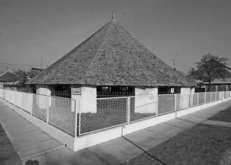In Kikinda, on the corner of Nemanjina and Moravska Street, there is a suvač, now the only object of its kind in Vojvodina. On April 19, 1889, Max Adamov of Kikinda bought from Paje Adamov from Kikinda for a sum of three forints, an empty plot of land, 250 acres of land, and used it for a few years as a garden. Right after ten years and eleven days, on April 30, 1899, Max Adamov sold this vacant land to thirty of his peasants from the neighborhood, who jointly on a cooperative basis approached the raising of the coffers at this place.
After they raised the loan to the necessary funds, the co-workers went to Padej and bought the entire material and parts of a suede, the owner of which was the Kikinda trader, the father of today’s protector in Kikinda, Kamenka Brancic.
With the size and dimensions of its construction, this coin does not expose itself much in its milieu. It does not even overshadow any of the surrounding buildings. Only when it comes to its immediate vicinity, then its unusual roof in the form of a multilateral pyramid falls into the eye. The roof is located on 14 low-walled columns built of bricks, and on the east side there is a smaller and lower part of the four-cornered base, built of charge. The whole building of the shed is covered with a tiny tile.
This larger swath part has no special name. It contains a part of the mechanism of the suave, which for putting the horse and its towage into operation, used stones for melting. The most important part of this mechanism is a large wooden horizontally mounted wheel – a circumference of 45 m, with twelve pads fixed to a vertical roller shaft, made of an oak boulder. This axis is called pop. For the purpose of strengthening the paws of the car, the maturas are connected to the upper part of the pope. On the outer edge of the car, fifty-five pieces of wooden teeth were fixed. With them, when the wheel in motion moves the energy on the spindles by pushing the carvings on them and thus putting on stones for melting. The lower part of the pope is chained and the shaft of the shackles rests on the iron tray, fixed in a stable stone backing. This iron deposit is called paprika.The upper part of the pope is narrowed in the roller neck and rests in a horizontally fixed tray between the roof beams. On one side of that bearing is a lever, called a tongue, which at one end is secured to the beams on either side, so that its part of the pope’s door can easily be lifted upward by a rope called ragged, made of knitted cannabis. By raising this tongue, the pope’s neck is released, so this can be pushed along with the wheel on the free side, to introduce and engage a horse. For the cutting of the horse, the trees are fixed for the collapse of the car.made of knitted cannabis. By raising this tongue, the pope’s neck is released, so this can be pushed along with the wheel on the free side, to introduce and engage a horse. For the cutting of the horse, the trees are fixed for the collapse of the car.made of knitted cannabis. By raising this tongue, the pope’s neck is released, so this can be pushed along with the wheel on the free side, to introduce and engage a horse. For the cutting of the horse, the trees are fixed for the collapse of the car.
Since the sucker had two pairs of rocks, two types of grains could be weighed at the same time, e.g. wheat and corn. The largest number of used straps has never exceeded five pairs of horses. In such cases, the sucker could, in full capacity, be able to harvest about 100 kg of cereals for one hour. For the minimal work of the soured, a pair of horses was required. In such cases, it was possible to grind with only one pair of stones, and it is understood much slower than it would have been possible to do, for example, with two pairs of horse ridges.
The ground floor with a circular trail of brick, 1.4 m wide, was used for horses. There is a mechanism inside the sucker which puts stones for grinding, horsepower. A ground-floor facility, whose roof exits from the roof of the courtyard, continues on the shed. The house has three rooms, of which the first mill part of the shed is a sieve, millstone and other parts of the mechanism. It enters this room directly from the yard. There are two more rooms in the house that served as a millet apartment, which is reached through the entrance to the mill.
SUVAČA


0 comments on “SUVAČA”